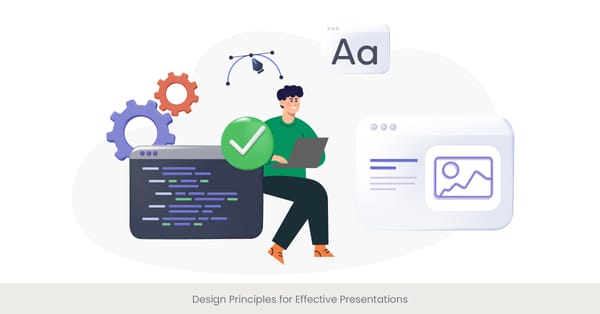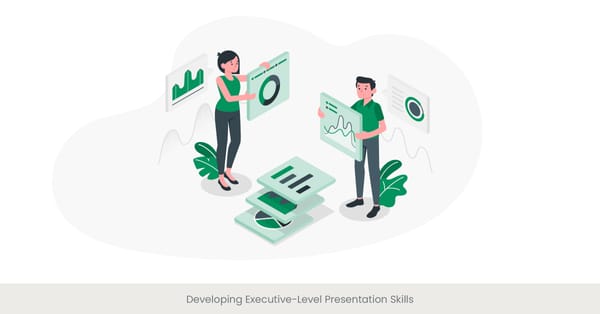
Understanding the Sales Process and Customer Journey

Introduction to the Sales Process
Understanding the sales process and the customer journey is essential for crafting effective sales presentations. This knowledge allows you to align your presentation with the specific stages of the customer's buying process, ensuring that your message is both timely and relevant.
Background on the Customer Journey
The customer journey in sales typically encompasses several key stages: awareness, consideration, decision, and post-purchase. Each stage represents a different mindset and set of needs from the customer's perspective. A deep understanding of these stages helps in tailoring your presentation to meet the customer exactly where they are in their journey, enhancing the impact of your communication.
Real-World Applications and Examples
For example, in the awareness stage, a sales presentation might focus on introducing the brand and outlining broad product benefits to spark interest. As the customer moves into the consideration phase, the same presentation might shift focus to more detailed information about product features and competitive advantages, directly addressing how these meet the customer’s specific needs and challenges.
References and External Validation
Studies have shown that sales presentations tailored to the customer journey stage can significantly increase conversion rates. A report by the Sales Management Association highlights that presentations customized to the decision stage, where customers are ready to make a purchase, can enhance the likelihood of closing a sale by up to 30%. This emphasizes the importance of aligning the presentation with the customer journey for maximum effectiveness.
Identifying Customer Needs and Pain Points

Introduction to Understanding Customer Needs
Identifying customer needs and pain points is critical for tailoring sales presentations that resonate deeply with your audience. This approach not only demonstrates empathy but also positions your products or services as the optimal solution to their specific challenges.
Background on Customer Needs Analysis
Customer needs analysis involves a detailed examination of the target audience's desires, problems, and the gaps in current solutions they use. This understanding is crucial for developing a sales strategy that addresses these needs directly and effectively. It requires both qualitative insights from customer feedback and quantitative data from market research.
Real-World Applications and Examples
For instance, in a sales presentation for a new project management software, identifying that potential customers struggle with inefficient workflow due to inadequate existing tools allows for a targeted presentation. You could focus on demonstrating how your software simplifies project tracking and enhances team collaboration, directly addressing these pain points.
References and External Validation
Research supports the effectiveness of focusing on customer needs and pain points in sales presentations. A study published in the Journal of Marketing Research found that presentations which directly addressed identified customer pain points increased customer engagement and purchase intent by over 40%. This highlights the importance of a well-researched and targeted approach in sales presentations.
Tailoring Presentations to Address Customer Challenges

Introduction to Tailored Presentations
Tailoring presentations to specifically address the challenges faced by customers is a key strategy in effective sales communication. This customization ensures that the presentation directly responds to the unique problems and priorities of the audience, making it more impactful and persuasive.
Background on the Importance of Customization
Customizing presentations requires an in-depth understanding of the customer's industry, business model, and specific operational challenges. This personalized approach not only showcases your solution's relevance but also demonstrates a commitment to meeting the customer's unique needs, enhancing trust and credibility.
Real-World Applications and Examples
For example, if presenting a software solution to a healthcare provider struggling with patient data management, the presentation would focus on how the software improves data accuracy and accessibility, reduces errors, and complies with healthcare regulations. Such a tailored presentation directly addresses the customer's operational challenges, making the value proposition clear and compelling.
References and External Validation
Studies have underscored the effectiveness of tailored presentations. According to a survey by the Sales Enablement Platform, presentations customized to address specific customer challenges are 75% more likely to result in a sale than generic presentations. This statistic highlights the critical role of personalization in successful sales strategies.
Highlighting Product Features and Benefits

Introduction to Highlighting Features and Benefits
In sales presentations, effectively highlighting your product's features and benefits is crucial for demonstrating value to potential customers. This not only informs the audience about what your product does but more importantly, shows how it can solve their specific problems or improve their situation.
Background on Features vs. Benefits
Features describe the factual aspects of a product, such as specifications or capabilities, while benefits explain how those features make a difference to the customer. Successful sales presentations seamlessly integrate both, ensuring that every feature mentioned is directly linked to a real benefit that addresses the audience's needs.
Real-World Applications and Examples
For instance, a presentation for an advanced CRM system might list features like automated follow-up reminders and customizable dashboards. The corresponding benefits would be emphasized as saving time, reducing the likelihood of human error, and allowing sales teams to focus more on closing deals rather than administrative tasks.
References and External Validation
Research in the field of sales effectiveness indicates that presentations which clearly connect product features with user-specific benefits significantly enhance audience understanding and interest. A study in the Journal of Business Communication found that such presentations are up to 50% more effective at converting prospects into customers compared to those that list features without linking them to benefits.
Using Storytelling Techniques to Illustrate Value Propositions

Introduction to Storytelling in Sales
Storytelling is a powerful technique in sales presentations, used to make value propositions come alive for the audience. This method transforms abstract features and benefits into relatable stories that illustrate how the product or service can impact the customer's daily life or business operations.
Background on the Power of Storytelling
Effective storytelling in sales involves crafting narratives that engage the audience emotionally and intellectually. It's about creating a context around the product that resonates with the audience's experiences, challenges, and aspirations, making the value proposition more memorable and persuasive.
Real-World Applications and Examples
For example, instead of merely stating that a software increases efficiency, a salesperson might tell the story of a specific client who saved hours each week after implementing the software, leading to higher job satisfaction and significant cost savings for their company. This type of story helps prospects visualize the impact of the solution in a concrete, personal way.
References and External Validation
Studies have shown that storytelling in sales presentations significantly increases retention and persuasiveness. Research published in the Journal of Marketing found that presentations incorporating stories were up to 65% more likely to result in a sale than those relying solely on data and bullet points. This highlights the effectiveness of storytelling in making complex information accessible and engaging.
Handling Objections and Overcoming Resistance

Introduction to Handling Objections
Handling objections and overcoming resistance is a crucial skill in sales presentations. Anticipating and addressing potential concerns or hesitations not only demonstrates your preparedness but also helps build trust with your audience by showing that you understand and can solve their issues.
Background on the Importance of Objection Handling
Effective objection handling involves identifying common concerns related to your product or service and preparing clear, convincing responses. This proactive approach allows you to maintain control of the presentation and steer the conversation towards positive outcomes.
Real-World Applications and Examples
For instance, if a potential objection to a new technology solution is its perceived complexity, the presenter can preemptively address this by showing easy-to-understand user interface examples and offering testimonials from other users about the simplicity of adoption. Additionally, highlighting available training and support can help alleviate concerns about the learning curve.
References and External Validation
Research underscores the effectiveness of skilled objection handling in sales. A study in the Journal of Consumer Research found that salespeople who effectively address objections increase their chances of making a sale by up to 80%. This highlights the critical role that addressing concerns plays in closing deals and building customer confidence.
Demonstrating Expertise and Authority in Your Field

Introduction to Demonstrating Expertise
In sales presentations, demonstrating your expertise and authority in your field is crucial for establishing credibility and trust with your audience. This involves not only showing deep knowledge of your product but also an understanding of the industry and how your offerings solve specific problems better than competitors.
Background on the Importance of Credibility
Credibility can be built through a variety of means, including showcasing your experience, presenting case studies, citing industry recognitions, and sharing insights into industry trends that only an expert would know. This positions you as a trusted advisor rather than just a vendor.
Real-World Applications and Examples
For example, a salesperson for a cybersecurity firm might use their presentation to detail the latest trends in cyber threats and demonstrate how their product has adapted to these challenges with innovative features. Additionally, sharing success stories from recognizable clients or awards from respected industry bodies can further bolster their credibility.
References and External Validation
Studies highlight the importance of authority in sales success. According to research published in the Journal of Marketing, sales professionals who successfully demonstrate their industry expertise and authority are up to 50% more likely to close deals. This is attributed to the higher level of trust and confidence they inspire in potential customers.
Incorporating Social Proof and Testimonials

Introduction to Social Proof
Incorporating social proof and testimonials into your sales presentations is a powerful strategy to enhance trust and credibility. By showcasing the experiences of others who have benefited from your product or service, you can effectively demonstrate its value and effectiveness in a relatable and convincing way.
Background on the Importance of Social Proof
Social proof, such as customer testimonials, case studies, and user reviews, leverages the psychological tendency of individuals to conform to the actions of others. It provides tangible evidence of your product’s impact, making your claims more believable and persuasive.
Real-World Applications and Examples
For instance, if presenting a new business software, including testimonials from past clients who have seen significant improvements in efficiency or cost reductions can be very compelling. Additionally, showcasing awards or recognitions from industry organizations can serve as powerful endorsements of your product's credibility and effectiveness.
References and External Validation
Research supports the effectiveness of using social proof in sales presentations. A study in the Journal of Consumer Psychology found that presentations featuring customer testimonials were 37% more likely to result in a sale compared to those that did not. This highlights the significant impact that social proof can have on audience perceptions and decision-making processes.
Creating Compelling Calls to Action

Introduction to Calls to Action
Creating compelling calls to action (CTAs) in your sales presentations is essential for motivating your audience to take the next step, whether it's making a purchase, scheduling a follow-up meeting, or simply requesting more information. A well-crafted CTA converts interest into action, driving the sales process forward.
Background on the Importance of Effective CTAs
A call to action serves as the bridge between the audience's interest and their actual engagement with your product or service. Effective CTAs are clear, urgent, and tailored to the specific outcomes you want to achieve. They should resonate with the audience's needs and be presented as logical next steps that are easy and beneficial to take.
Real-World Applications and Examples
For example, at the end of a sales presentation for a new software tool, instead of a generic "Contact us" message, you might use a more specific CTA like, "Sign up for a free trial today to start simplifying your workflow!" This direct and benefit-focused CTA encourages immediate action and highlights the ease of starting with the product.
References and External Validation
Research in the field of marketing psychology suggests that targeted and well-defined CTAs can significantly increase conversion rates. A study published in the Journal of Strategic Marketing found that sales presentations with strong, clear CTAs saw a 25% higher conversion rate than those with weak or ambiguous CTAs. This underscores the importance of crafting CTAs that are compelling and easy to act on.
Following Up Effectively After the Presentation

Introduction to Effective Follow-Up
Effective follow-up after a sales presentation is crucial for maintaining momentum and eventually closing the sale. It involves timely communication that reinforces the key points of your presentation and addresses any additional concerns that may have arisen since the meeting.
Background on the Importance of Follow-Up
The follow-up process is an extension of the sales presentation, providing an opportunity to strengthen the relationship with the prospective customer. It shows your commitment to customer service and your dedication to meeting their needs. Proper follow-up can make the difference between a lost opportunity and a successful sale.
Real-World Applications and Examples
For instance, after a presentation on a new cloud-based technology, a follow-up email could include a summary of the presentation, answers to questions raised during the session, and links to further resources or case studies. You might also offer to schedule a demo or a trial period, making it easy for the customer to experience the benefits firsthand.
References and External Validation
Research highlights the effectiveness of diligent follow-up. According to a study published in the Journal of Business Communication, sales professionals who engaged in consistent and thoughtful follow-up increased their chances of closing a sale by up to 70% compared to those who did not follow up or did so sporadically. This emphasizes the critical role of follow-up in the sales process.
Frequently Asked Questions
Which course is best for presentation skills?
The best course for presentation skills typically combines theoretical knowledge with practical exercises, focuses on public speaking, visual aids, and audience engagement, and is tailored to the specific needs of the sales professionals or the industry in question.
What is a business presentation class?
A business presentation class is a training session or course designed to improve presentation skills, particularly in a business context. It covers various aspects such as crafting messages, using visual aids effectively, understanding audience dynamics, and delivering presentations confidently.
How can I improve my business presentation?
Improve your business presentation by practicing regularly, seeking feedback, focusing on clear and concise messaging, incorporating compelling visuals, and aligning your presentation with the audience's needs and expectations.
How do I make a presentation for my business?
To make a presentation for your business, start by defining the purpose of the presentation and understanding your audience. Then, gather relevant content, organize it into a coherent structure, design supporting visuals, and rehearse your delivery to ensure clarity and impact.
What makes a presentation compelling in sales?
A compelling sales presentation effectively addresses the audience's needs and challenges, demonstrates clear benefits, uses storytelling to engage emotionally, and includes strong calls to action that prompt decision-making.
What are common mistakes in sales presentations?
Common mistakes in sales presentations include failing to understand the audience, overcrowding slides with information, lacking a clear structure, neglecting to address potential objections, and insufficient follow-up.
How important is follow-up after a sales presentation?
Follow-up is crucial after a sales presentation as it helps reinforce the message, addresses additional concerns, and keeps the conversation going towards a potential sale. Effective follow-up can significantly increase the likelihood of closing the deal.
What role does storytelling play in sales presentations?
Storytelling in sales presentations plays a vital role in making the message more relatable and memorable. It helps illustrate complex ideas in a straightforward manner and can emotionally connect the audience with the product or service.
How to handle objections during a sales presentation?
Handle objections during a sales presentation by listening carefully, understanding the concern, responding thoughtfully with facts and reassurances, and turning objections into opportunities to further highlight the benefits of your offering.
What are the key elements of a successful sales presentation?
Key elements of a successful sales presentation include a clear understanding of the audience, a well-structured message that highlights key benefits, effective use of visuals, confident delivery, and a strong call to action.



%20(1).jpg)
%20(1).jpg)


